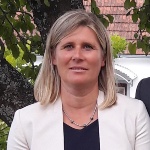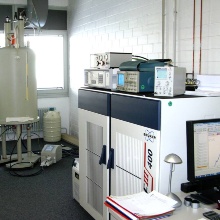Pulsed field gradient NMR is a powerful method for obtaining the molecular displacements of the order of micrometers. With this sensitivity, it is possible to characterise the microstructure of surfactant systems such as microemulsions, since the size of the microemulsion droplets are smaller. Therefore, the microstructure of microemulsions can be studied by comparing the translations of the different components presents in the system [1]. For the type of microemulsion of oil droplets dispersed in the water phase (or vice versa), the translation of the dispersed phase molecules corresponds to the translation of the entire droplet. This translation is typically 2 orders of magnitude lower than the diffusion of the continuous phase molecules. In a bicontinuous microemulsion the translation of oil and water molecules are of the same order of magnitude. Thus, the translations of the different components of the microemulsion provide us information concerning connectivity of the different phases.
The physico-chemical parameter used to describe these translations is the self-diffusion coefficient D. To determine it, pulsed field gradient stimulated spin echo (PFG-STE-NMR) [2] is used.
As it is shown in figure 1, this pulse sequence consists in three radiofrequency pulses which are combined with two equal and rectangular gradient pulses of magnitude g and length δ. The resulting spin echo (NMR signal) is Fourier transformed. The Stejskal-Tanner equation [4] relates the intensity of each NMR resonances with the self-diffusion coefficients.

where Ao is the echo amplitude without applied gradients, γ is the gyromagnetic ratio and Δ is the time interval between gradient pulses and thus the observation time. The PFG-STE-NMR experiment is performed by recording NMR spectra as a function of g while δ and Δ are kept constant.
| [1] Structure of Microemulsions Studied by NMR, B. Lindman, U. Olsson, Ber. Bunsen Ges. Phys. Chem., 1996, 100,344-363. |
| [2] Use of the Stimulated Echo in NMR Diffusion Studies, J. E. Tanner, J. Chem. Phys., 1970, 52,2523-2526. |
| [3] Diffusion – NMR User Manual Version 003, K. Zick, BRUKER BioSpin, 2009,Rheinstetten, Germany. |
| [4] Spin Diffusion Measurements: Spin Echoes in the Presence of a Time-Dependent Field Gradient, E. O. Stejskal, J. E. Tanner, J. Chem. Phys., 1965, 42, 288-292. |

Philipp Menold
Dr.Postdoctoral Research Associate

Diana Sottmann
CTA



